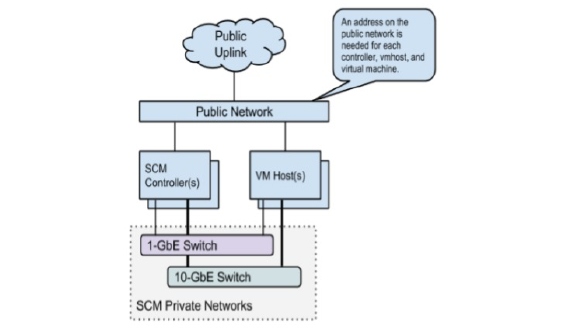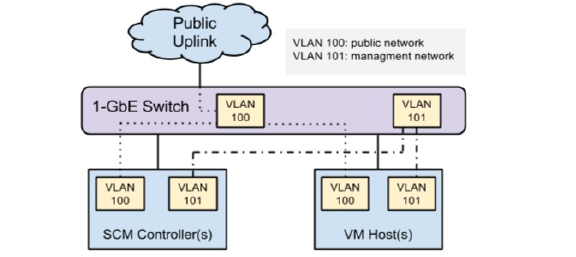Networking Overview¶
SCM defines and uses three networks:
- The public network.
- A 1-GbE management network.
- A 10-GbE data network.
The public network is used to allow external access to the Cloud Portal, SCM APIs, and virtual machines. VMs and SCM hosts use the public network to route out to the Internet. Note that the word public may not mean that nodes on the public network necessarily have a routable IP address; this may be an internal LAN or Intranet. The public network connections can be 1-GbE or 10-GbE, depending on port availability and uplink connection type.
The 1-GbE management network is a private network between the SCM nodes. This network is used for SSH and administrative traffic.
The 10-GbE data network is used as a high-bandwidth network between the SCM nodes. All inter-node communication between SCM nodes occurs over the data network. This includes Ceph data replication and client storage traffic, OpenStack communication, and MySQL network traffic.
The following diagram shows a logical overview of the SCM networks.

Note that networking can be implemented in many different ways. The public network may be attached via 1-GbE or 10-GbE connections. The public connection may incorporate the use of tagged or untagged virtual local area networks (VLANs). The most flexible method is when using tagged VLANs, and configuring the switches for a “trunked” connection to the SCM nodes. That would enable a configuration like this:

This VLAN example shows that a single 1-GbE switch could be used to handle both the public network and the management network. Additionally, the SCM nodes also support network bonding via link aggregation control protocol (LACP), if multiple connections to a switch are available. This is most useful when two switches are configured as an active/active pair via Scyld Cloud Controller (MLAG).